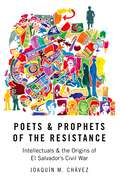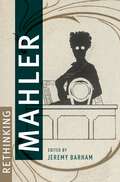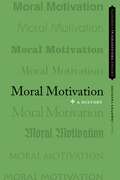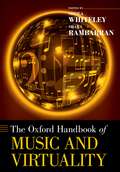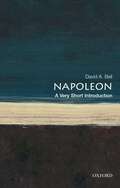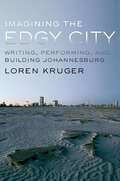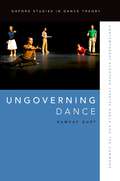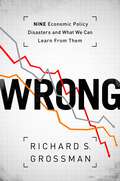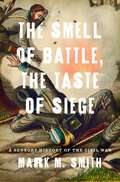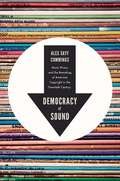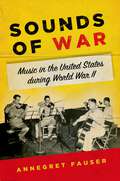- Table View
- List View
Poets and Prophets of the Resistance: Intellectuals and the Origins of El Salvador's Civil War
by Joaquín M. ChávezPoets and Prophets of the Resistance offers a ground-up history and fresh interpretation of the polarization and mobilization that brought El Salvador to the eve of civil war in 1980. Challenging the dominant narrative that university students and political dissidents primarily formed the Salvadoran guerrillas, Joaquín Chávez argues that El Salvador's socioeconomic and political crises of the 1970s fomented a groundswell of urban and peasant intellectuals who collaborated to spur larger revolutionary social movements. Drawing on new archival sources and in-depth interviews, Poets and Prophets of the Resistance contests the idea that urban militants and Roman Catholic priests influenced by Liberation Theology single-handedly organized and politicized peasant groups. Chávez shows instead how peasant intellectuals acted as political catalysts among their own communities first, particularly in the region of Chalatenango, laying the groundwork for the peasant movements that were to come. In this way, he contends, the Salvadoran insurgency emerged in a dialogue between urban and peasant intellectuals working together to create and execute a common revolutionary strategy--one that drew on cultures of resistance deeply rooted in the country's history, poetry, and religion. Focusing on this cross-pollination, this book introduces the idea that a "pedagogy of revolution" originated in this historical alliance between urban and peasant, making use of secular and Catholic pedagogies such as radio schools, literacy programs, and rural cooperatives. This pedagogy became more and more radicalized over time as it pushed back against the increasingly repressive structures of 1970s El Salvador. Teasing out the roles of little-known groups such as the politically active "La Masacuata" literary movement, the contributions of Catholic Action intellectuals to the New Left, and the overlooked efforts of peasant leaders, Poets and Prophets of the Resistance demonstrates how trans-class political and cultural interactions drove the revolutionary mobilizations that anticipated the Salvadoran civil war.
Tolerance: A Sensorial Orientation to Politics
by Lars TønderIn Tolerance, Lars Tønder offers a thought-provoking theory on what tolerance means in pluralistic societies. Tønder begins by showing the limitations of the way democratic theory currently understands tolerance: either as a form of restraint or as benevolence, but always divorced from what it is that the tolerant person really senses. According to Tønder, what is missing from current theories of tolerance is the idea of pain, or the lived experience of what it means to become tolerant. Introducing what he calls a "sensorial orientation to politics" and a "theory of active tolerance," he argues that the act of becoming tolerant (and the reasoning it entails) depends on sensing the world in an expansive manner attentive to the new and unforeseen. In order to illustrate, he engages with a number of theorists, from Seneca, Spinoza, Nietzsche, Merleau-Ponty, and Marcuse to Locke, Kant and Mill, and he draws upon a wide range of examples, including the 2005 controversy over the Danish cartoons of Muhammad, Sacher-Masoch's Venus in Furs, Dave Chappelle's comedy, and methods of torture used in the war on terror. Tolerance is at once a sweeping account of the history of political thought and an invitation to rethink the meaning of tolerance within the sensorial conditions that define twenty first century democratic politics.
The Syro-Anatolian City-States: An Iron Age Culture (Oxford Studies in the Archaeology of Ancient States)
by James F. OsborneThis book presents a new model for understanding the collection of ancient kingdoms that surrounded the northeast corner of the Mediterranean Sea from the Cilician Plain in the west to the upper Tigris River in the east, and from Cappadocia in the north to western Syria in the south, during the Iron Age of the ancient Near East (ca. 1200 to 600 BCE). Rather than presenting them as homogenous ethnolinguistic communities like "the Aramaeans" or "the Luwians" living in neatly bounded territories, this book sees these polities as being fundamentally diverse and variable, distinguished by demographic fluidity and cultural mobility. The Syro-Anatolian City-States sheds new light via an examination of a host of evidentiary sources, including archaeological site plans, settlement patterns, visual arts, and historical sources. Together, these lines of evidence reveal a complex fusion of cultural traditions that is nevertheless distinctly recognizable unto itself. This book is the first to specifically characterize the Iron Age city-states of southeastern Turkey and northern Syria, arguing for a unified cultural formation characterized above all by diversity and mobility and that can be referred to as the "Syro-Anatolian Culture Complex."
Rethinking Mahler
As one of the most popular classical composers in the performance repertoire of professional and amateur orchestras and choirs across the world, Gustav Mahler continues to generate significant interest, and the global appetite for his music, and for discussions of it, remains large. Editor Jeremy Barham brings together leading and emerging scholars in the field to explore Mahler's relationship with music, media, and ideas past and present, addressing issues in structural analysis, performance, genres of stage, screen and literature, cultural movements, aesthetics, history/historiography and temporal experience. Rethinking Mahler counterbalances prevailing scholarly assumptions and preferences that configure Mahler as proto-modernist, with hitherto neglected consideration of his debt to, and his re-imagining of, the legacies of his own historical past. Over the course of 17 chapters drawing from a variety of disciplinary perspectives, the book pursues ideas of nostalgia, historicism and 'pastness' in relation to an emergent modernity and subsequent musical-cultural developments, yielding a wide-ranging exploration and re-evaluation of Mahler's works, their historical reception and understanding, and their resounding impact within diverse cultural contexts. Rethinking Mahler will be an essential resource for scholars and students of Mahler and late Romantic era music more generally, and will also find an audience among the many devotees of Mahler's music.
Westmoreland's War: Reassessing American Strategy in Vietnam
by Gregory DaddisGeneral William C. Westmoreland has long been derided for his failed strategy of "attrition" in the Vietnam War. Historians have argued that Westmoreland's strategy placed a premium on high "body counts" through a "big unit war" that relied almost solely on search and destroy missions. Many believe the U.S. Army failed in Vietnam because of Westmoreland's misguided and narrow strategy In a groundbreaking reassessment of American military strategy in Vietnam, Gregory Daddis overturns conventional wisdom and shows how Westmoreland did indeed develop a comprehensive campaign which included counterinsurgency, civic action, and the importance of gaining political support from the South Vietnamese population. Exploring the realities of a large, yet not wholly unconventional environment, Daddis reinterprets the complex political and military battlefields of Vietnam. Without searching for blame, he analyzes how American civil and military leaders developed strategy and how Westmoreland attempted to implement a sweeping strategic vision. Westmoreland's War is a landmark reinterpretation of one of America's most divisive wars, outlining the multiple, interconnected aspects of American military strategy in Vietnam-combat operations, pacification, nation building, and the training of the South Vietnamese armed forces. Daddis offers a critical reassessment of one of the defining moments in American history.
Westmoreland's War: Reassessing American Strategy in Vietnam
by Gregory DaddisGeneral William C. Westmoreland has long been derided for his failed strategy of "attrition" in the Vietnam War. Historians have argued that Westmoreland's strategy placed a premium on high "body counts" through a "big unit war" that relied almost solely on search and destroy missions. Many believe the U.S. Army failed in Vietnam because of Westmoreland's misguided and narrow strategy In a groundbreaking reassessment of American military strategy in Vietnam, Gregory Daddis overturns conventional wisdom and shows how Westmoreland did indeed develop a comprehensive campaign which included counterinsurgency, civic action, and the importance of gaining political support from the South Vietnamese population. Exploring the realities of a large, yet not wholly unconventional environment, Daddis reinterprets the complex political and military battlefields of Vietnam. Without searching for blame, he analyzes how American civil and military leaders developed strategy and how Westmoreland attempted to implement a sweeping strategic vision. Westmoreland's War is a landmark reinterpretation of one of America's most divisive wars, outlining the multiple, interconnected aspects of American military strategy in Vietnam-combat operations, pacification, nation building, and the training of the South Vietnamese armed forces. Daddis offers a critical reassessment of one of the defining moments in American history.
Moral Motivation: A History (Oxford Philosophical Concepts)
Moral Motivation presents a history of the concept of moral motivation. The book consists of ten chapters by eminent scholars in the history of philosophy, covering Plato, Aristotle, later Peripatetic philosophy, medieval philosophy, Spinoza, Locke, Hume, Kant, Fichte and Hegel, and the consequentialist tradition. In addition, four interdisciplinary "Reflections" discuss how the topic of moral motivation arises in epic poetry, Cicero, early opera, and Theodore Dreiser. Most contemporary philosophical discussions of moral motivation focus on whether and how moral beliefs by themselves motivate an agent (at least to some degree) to act. In much of the history of the concept, especially before Hume, the focus is rather on how to motivate people to act morally as well as on what sort of motivation a person must act from (or what end an agents acts for) in order to be a genuinely ethical person or even to have done a genuinely ethical action. The book shows the complexity of the historical treatment of moral motivation and, moreover, how intertwined moral motivation is with central aspects of ethical theory.
The Oxford Handbook of Music and Virtuality (Oxford Handbooks)
by Sheila Whiteley Shara RambarranHas the virtual invaded the realm of the real, or has the real expanded its definition to include what once was characterized as virtual? With the continual evolution of digital technology, this distinction grows increasingly hazy. But perhaps the distinction has become obsolete; perhaps it is time to pay attention to the intersections, mutations, and transmigrations of the virtual and the real. Certainly it is time to reinterpret the practice and study of music. The Oxford Handbook of Music and Virtuality, edited by Sheila Whiteley and Shara Rambarran, is the first book to offer a kaleidoscope of interdisciplinary perspectives from scholars around the globe on the way in which virtuality mediates the dissemination, acquisition, performance, creation, and reimagining of music. The Oxford Handbook of Music and Virtuality addresses eight themes that often overlap and interact with one another. Questions of the role of the audience, artistic agency, individual and communal identity, subjectivity, and spatiality repeatedly arise. Authors specifically explore phenomena including holographic musicians and virtual bands, and the benefits and detriments surrounding the free circulation of music on the internet. In addition, the book investigates the way in which fans and musicians negotiate gender identities as well as the dynamics of audience participation and community building in a virtual environment. The handbook rehistoricizes the virtual by tracing its progression from cartoons in the 1950s to current industry innovations and changes in practice. Well-grounded and wide-reaching, this is a book that students of any number of disciplines, from Music to Cultural Studies, have awaited.
Napoleon: A Very Short Introduction (Very Short Introductions)
by David A. BellThis Very Short Introduction might prove disappointing to those expecting an introduction to a very short man. Dispelling the myth of Napoleon Bonaparte's short stature, as well as the other rumors and legends, David A. Bell provides a concise, accurate, and lively portrait of Napoleon Bonaparte's character and career, situating him firmly in historical context. This book emphasizes the astonishing sense of human possibility--for both good and ill--that Napoleon represented. By his late twenties, Napoleon was already one of the greatest generals in European history. At thirty, he had become absolute master of Europe's most powerful country. In his early forties, he ruled a European empire more powerful than any since Rome, fighting wars that changed the shape of the continent and brought death to millions. Then everything collapsed, leading him to spend his last years in miserable exile in the South Atlantic. Bell underscores the importance of the French Revolution in understanding Napoleon's career. The revolution made possible the unprecedented concentration of political authority that Napoleon accrued, and his success in mobilizing human and material resources for war. Without the political changes brought about by the revolution, Napoleon could not have fought his wars. Without the wars, he could not have seized and held onto power. Though his virtual dictatorship betrayed the ideals of liberty and equality, his life and career were revolutionary.
Napoleon: Toward A Political History Of Madness (Very Short Introductions)
by David A. BellThis Very Short Introduction might prove disappointing to those expecting an introduction to a very short man. Dispelling the myth of Napoleon Bonaparte's short stature, as well as the other rumors and legends, David A. Bell provides a concise, accurate, and lively portrait of Napoleon Bonaparte's character and career, situating him firmly in historical context. This book emphasizes the astonishing sense of human possibility--for both good and ill--that Napoleon represented. By his late twenties, Napoleon was already one of the greatest generals in European history. At thirty, he had become absolute master of Europe's most powerful country. In his early forties, he ruled a European empire more powerful than any since Rome, fighting wars that changed the shape of the continent and brought death to millions. Then everything collapsed, leading him to spend his last years in miserable exile in the South Atlantic. Bell underscores the importance of the French Revolution in understanding Napoleon's career. The revolution made possible the unprecedented concentration of political authority that Napoleon accrued, and his success in mobilizing human and material resources for war. Without the political changes brought about by the revolution, Napoleon could not have fought his wars. Without the wars, he could not have seized and held onto power. Though his virtual dictatorship betrayed the ideals of liberty and equality, his life and career were revolutionary.
Imagining the Edgy City: Writing, Performing, and Building Johannesburg
by Loren Kruger"All roads lead to Johannesburg," remarks the narrator of Alan Paton's novel Cry, The Beloved Country. Taking this quote as her impetus, Loren Kruger guides readers into the heart of South Africa's largest city. Exploring a wide range of fiction, film, architecture, performance, and urban practices from trading to parades, Imagining the Edgy City traverses Johannesburg's rich cultural terrain over the last century. The "edgy city" in Kruger's exploration refers not only to persistent boundaries between the haves and have-nots but also to the cosmopolitan diversity and innovation that has emerged from Johannesburg. The book begins with the building boom, performances and uneven but noteworthy inter-racial exchange that marked the city's fiftieth-anniversary celebration at the Empire Exhibition in 1936. This celebration rapidly gave way to the political repression and civil unrest that characterized South Africa from 1950 to 1990. Yet poetry, drama, fiction, and photography continued to thrive, bearing witness not only against apartheid but to alternatives beyond it. In the late twentieth century, the not quite post-apartheid condition fired the artistic imaginations of film makers as well as novelists. Urban neglect, rising crime, and the influx of migrants inspired noir cinema-like Michael Hammon's Wheels and Deals-and fiction about migration from Achmat Dangor to Phaswane Mpe, and in the twenty-first, urban renewal has produced public art that incorporates the desire lines of newcomers as well as natives. Alongside well-known artists such as Nadine Gordimer, William Kentridge, and David Goldblatt, the book introduces many artists, architects, writers, and other chroniclers who have hitherto received little attention abroad. Ultimately, Johannesburg emerges as a city whose negotiation of the tensions between incivility and innovation invites comparisons with modern conurbations across the world, not only African cities such as Dakar, or other cities of the "south" such as Bogotá, but also with major metropolises in North America and Europe from Chicago to Paris. A multi-faceted work that speaks to scholars in urban studies, literature, and history, Imagining the Edgy City is a rich example of interdisciplinary scholarship at its best.
Ungoverning Dance: Contemporary European Theatre Dance and the Commons (Oxford Studies in Dance Theory)
by Ramsay BurtUngoverning Dance examines the work of progressive contemporary dance artists in continental Europe from the mid 1990s to 2015. Placing this within the context of neoliberalism and austerity, the book argues that these artists have developed an ethico-aesthetic approach that uses dance practices as sites of resistance against dominant ideologies, and that their works attest to the persistence of alternative ways of thinking and living. In response to the way that the radical values informing their work are continually under attack from neoliberalism, these artists recognise that they in effect share common pool resources. Thus, while contemporary dance has been turned into a market, they nevertheless value the extent to which it functions as a commons. Work that does this, it argues, ungoverns dance. The book offers close readings of works from the 1990s and 2000s by two generations of European-based dance artists: that of Jérôme Bel, Jonathan Burrows, La Ribot, and Xavier Le Roy who began showing work in the 1990s; and that of artists who emerged in the 2000s including Fabián Barba, Faustin Linyekula, Ivana Müller, and Nikolina Pristas. Topics examined include dance and precarious life, choreographing friendship, re-performance, the virtual in dance, and a dancer's experience of the Egyptian revolution. Ungoverning Dance proposes new ways of understanding recent contemporary European dance works by making connections with their social, political, and theoretical contexts.
Americans in a World at War: Intimate Histories from the Crash of Pan Am's Yankee Clipper
by Brooke L. BlowerA vivid narrative of an ill-fated Pan American flight during World War II that captures the dramatic backstories of its passengers and, through them, the impact of Americans' global connections. On February 21, 1943, Pan American Airways' celebrated seaplane, the Yankee Clipper, took off from New York's Marine Air Terminal and island-hopped its way across the Atlantic Ocean. Arriving at Lisbon the following evening, it crashed in the Tagus River, killing twenty-four of its thirty-nine passengers and crew. Americans in a World at War traces the backstories of seven worldly Americans aboard that plane, their personal histories, their politics, and the paths that led them toward war. Combat soldiers made up only a small fraction of the millions of Americans, both in and out of uniform, who scattered across six continents during the Second World War. This book uncovers a surprising history of American noncombatants abroad in the years leading into the twentieth century's most consequential conflict. Long before GIs began storming beaches and liberating towns, Americans had forged extensive political, economic, and personal ties to other parts of the world. These deep and sometimes contradictory engagements, which preceded the bombing of Pearl Harbor, would shape and in turn be transformed by the US war effort. The intriguing biographies of the Yankee Clipper's passengers--among them an Olympic-athlete-turned-export salesman, a Broadway star, a swashbuckling pilot, and two entrepreneurs accused of trading with the enemy--upend conventional American narratives about World War II. As their travels take them from Ukraine, France, Spain, Panama, Cuba, and the Philippines to Java, India, Australia, Britain, Egypt, the Soviet Union, and the Belgian Congo, among other hot spots, their movements defy simple boundaries between home front and war front. Americans in a World at War offers fresh perspectives on a transformative period of US history and global connections during the "American Century."
Americans in a World at War: Intimate Histories from the Crash of Pan Am's Yankee Clipper
by Brooke L. BlowerA vivid narrative of an ill-fated Pan American flight during World War II that captures the dramatic backstories of its passengers and, through them, the impact of Americans' global connections. On February 21, 1943, Pan American Airways' celebrated seaplane, the Yankee Clipper, took off from New York's Marine Air Terminal and island-hopped its way across the Atlantic Ocean. Arriving at Lisbon the following evening, it crashed in the Tagus River, killing twenty-four of its thirty-nine passengers and crew. Americans in a World at War traces the backstories of seven worldly Americans aboard that plane, their personal histories, their politics, and the paths that led them toward war. Combat soldiers made up only a small fraction of the millions of Americans, both in and out of uniform, who scattered across six continents during the Second World War. This book uncovers a surprising history of American noncombatants abroad in the years leading into the twentieth century's most consequential conflict. Long before GIs began storming beaches and liberating towns, Americans had forged extensive political, economic, and personal ties to other parts of the world. These deep and sometimes contradictory engagements, which preceded the bombing of Pearl Harbor, would shape and in turn be transformed by the US war effort. The intriguing biographies of the Yankee Clipper's passengers--among them an Olympic-athlete-turned-export salesman, a Broadway star, a swashbuckling pilot, and two entrepreneurs accused of trading with the enemy--upend conventional American narratives about World War II. As their travels take them from Ukraine, France, Spain, Panama, Cuba, and the Philippines to Java, India, Australia, Britain, Egypt, the Soviet Union, and the Belgian Congo, among other hot spots, their movements defy simple boundaries between home front and war front. Americans in a World at War offers fresh perspectives on a transformative period of US history and global connections during the "American Century."
WRONG: Nine Economic Policy Disasters and What We Can Learn from Them
by Richard S. GrossmanIn recent years, the world has been rocked by major economic crises, most notably the devastating collapse of Lehman Brothers, the largest bankruptcy in American history, which triggered the breathtakingly destructive sub-prime disaster. What sparks these vast economic calamities? Why do our economic policy makers fail to protect us from such upheavals? In Wrong, economist Richard Grossman addresses such questions, shining a light on the poor thinking behind nine of the worst economic policy mistakes of the past 200 years, missteps whose outcomes ranged from appalling to tragic. Grossman tells the story behind each misconceived economic move, explaining why the policy was adopted, how it was implemented, and its short- and long-term consequences. In each case, he shows that the main culprits were policy makers who were guided by ideology rather than economics. For instance, Wrong looks at how America's unfounded fear of a centralized monetary authority caused them to reject two central banks, condemning the nation to wave after wave of financial panics. He describes how Britain's blind commitment to free markets, rather than to assisting the starving in Ireland, led to one of the nineteenth century's worst humanitarian tragedies- the Irish famine. And he shows how Britain's reestablishment of the gold standard after World War I, fuelled largely by a desire to recapture its pre-war dominance, helped to turn what would otherwise have been a normal recession into the Great Depression. Grossman also explores the Smoot-Hawley Tariff of 1930, Japan's lost decade of the 1990s, the American subprime crisis, and the present European sovereign debt crisis. Economic policy should be based on cold, hard economic analysis, Grossman concludes, not on an unquestioning commitment to a particular ideology. Wrong shows what happens when this sensible advice is ignored.
WRONG: Nine Economic Policy Disasters and What We Can Learn from Them
by Richard S. GrossmanIn recent years, the world has been rocked by major economic crises, most notably the devastating collapse of Lehman Brothers, the largest bankruptcy in American history, which triggered the breathtakingly destructive sub-prime disaster. What sparks these vast economic calamities? Why do our economic policy makers fail to protect us from such upheavals? In Wrong, economist Richard Grossman addresses such questions, shining a light on the poor thinking behind nine of the worst economic policy mistakes of the past 200 years, missteps whose outcomes ranged from appalling to tragic. Grossman tells the story behind each misconceived economic move, explaining why the policy was adopted, how it was implemented, and its short- and long-term consequences. In each case, he shows that the main culprits were policy makers who were guided by ideology rather than economics. For instance, Wrong looks at how America's unfounded fear of a centralized monetary authority caused them to reject two central banks, condemning the nation to wave after wave of financial panics. He describes how Britain's blind commitment to free markets, rather than to assisting the starving in Ireland, led to one of the nineteenth century's worst humanitarian tragedies- the Irish famine. And he shows how Britain's reestablishment of the gold standard after World War I, fuelled largely by a desire to recapture its pre-war dominance, helped to turn what would otherwise have been a normal recession into the Great Depression. Grossman also explores the Smoot-Hawley Tariff of 1930, Japan's lost decade of the 1990s, the American subprime crisis, and the present European sovereign debt crisis. Economic policy should be based on cold, hard economic analysis, Grossman concludes, not on an unquestioning commitment to a particular ideology. Wrong shows what happens when this sensible advice is ignored.
Burning the Reichstag: An Investigation into the Third Reich's Enduring Mystery
by Benjamin Carter HettIn February 1933, Adolf Hitler had only a tenuous grasp on power. Chancellor of Germany for merely four weeks, he led a fragile coalition government. The Nazis had lost seats in the Reichstag in the recent election, and claimed only three of thirteen cabinet posts. Then on February 27th, arson sent the Reichstag, the home and symbol of German democracy, up in flames. Immediately blaming the Communists, Hitler's new government approved a decree that tore the heart out of the democratic constitution of the Weimar Republic and cancelled the rule of law. Five thousand people were immediately arrested. The Reichstag fire marked the true beginning of the Third Reich, which ruled for 12 more years. The controversy surrounding the fire's origins has endured for 80. In Burning the Reichstag, Benjamin Hett offers a gripping account of Hitler's rise to dictatorship-one that challenges orthodoxy and recovers the true significance of the part the fire played. At the scene the police arrested 23-year-old Marinus van der Lubbe, a Dutch Communist stonemason. Though he was initially dismissed abroad as a Nazi tool, post-war historians since the 1950s have largely judged him solely guilty-a lone arsonist exploited by Hitler. Hett's book reopens the case, providing vivid portraits of key figures, including Rudolf Diels, Hermann Goering, Joseph Goebbels, and the historian Fritz Tobias, whose account of the fire has, until now, been the standard. Making use of a number of new sources and archives, Hett sets the Reichstag fire in a wider context, revealing how and why it has remained one of the last mysteries of the Nazi period, and one of the most controversial and contested events in the 20th century.
Burning the Reichstag: An Investigation into the Third Reich's Enduring Mystery
by Benjamin Carter HettIn February 1933, Adolf Hitler had only a tenuous grasp on power. Chancellor of Germany for merely four weeks, he led a fragile coalition government. The Nazis had lost seats in the Reichstag in the recent election, and claimed only three of thirteen cabinet posts. Then on February 27th, arson sent the Reichstag, the home and symbol of German democracy, up in flames. Immediately blaming the Communists, Hitler's new government approved a decree that tore the heart out of the democratic constitution of the Weimar Republic and cancelled the rule of law. Five thousand people were immediately arrested. The Reichstag fire marked the true beginning of the Third Reich, which ruled for 12 more years. The controversy surrounding the fire's origins has endured for 80. In Burning the Reichstag, Benjamin Hett offers a gripping account of Hitler's rise to dictatorship-one that challenges orthodoxy and recovers the true significance of the part the fire played. At the scene the police arrested 23-year-old Marinus van der Lubbe, a Dutch Communist stonemason. Though he was initially dismissed abroad as a Nazi tool, post-war historians since the 1950s have largely judged him solely guilty-a lone arsonist exploited by Hitler. Hett's book reopens the case, providing vivid portraits of key figures, including Rudolf Diels, Hermann Goering, Joseph Goebbels, and the historian Fritz Tobias, whose account of the fire has, until now, been the standard. Making use of a number of new sources and archives, Hett sets the Reichstag fire in a wider context, revealing how and why it has remained one of the last mysteries of the Nazi period, and one of the most controversial and contested events in the 20th century.
The Smell of Battle, the Taste of Siege: A Sensory History of the Civil War
by Mark M. SmithHistorical accounts of major events have almost always relied upon what those who were there witnessed. Nowhere is this truer than in the nerve-shattering chaos of warfare, where sight seems to confer objective truth and acts as the basis of reconstruction. In The Smell of Battle, the Taste of Siege, historian Mark M. Smith considers how all five senses, including sight, shaped the experience of the Civil War and thus its memory, exploring its full sensory impact on everyone from the soldiers on the field to the civilians waiting at home. From the eardrum-shattering barrage of shells announcing the outbreak of war at Fort Sumter; to the stench produced by the corpses lying in the mid-summer sun at Gettysburg; to the siege of Vicksburg, once a center of Southern culinary aesthetics and starved into submission, Smith recreates how Civil War was felt and lived. Relying on first-hand accounts, Smith focuses on specific senses, one for each event, offering a wholly new perspective. At Bull Run, the similarities between the colors of the Union and Confederate uniforms created concern over what later would be called "friendly fire" and helped decide the outcome of the first major battle, simply because no one was quite sure they could believe their eyes. He evokes what it might have felt like to be in the HL Hunley submarine, in which eight men worked cheek by jowl in near-total darkness in a space 48 inches high, 42 inches wide. Often argued to be the first "total war," the Civil War overwhelmed the senses because of its unprecedented nature and scope, rendering sight less reliable and, Smith shows, forcefully engaging the nonvisual senses. Sherman's March was little less than a full-blown assault on Southern sense and sensibility, leaving nothing untouched and no one unaffected. Unique, compelling, and fascinating, The Smell of Battle, The Taste of Siege, offers readers way to experience the Civil War with fresh eyes.
The Smell of Battle, the Taste of Siege: A Sensory History of the Civil War
by Mark M. SmithHistorical accounts of major events have almost always relied upon what those who were there witnessed. Nowhere is this truer than in the nerve-shattering chaos of warfare, where sight seems to confer objective truth and acts as the basis of reconstruction. In The Smell of Battle, the Taste of Siege, historian Mark M. Smith considers how all five senses, including sight, shaped the experience of the Civil War and thus its memory, exploring its full sensory impact on everyone from the soldiers on the field to the civilians waiting at home. From the eardrum-shattering barrage of shells announcing the outbreak of war at Fort Sumter; to the stench produced by the corpses lying in the mid-summer sun at Gettysburg; to the siege of Vicksburg, once a center of Southern culinary aesthetics and starved into submission, Smith recreates how Civil War was felt and lived. Relying on first-hand accounts, Smith focuses on specific senses, one for each event, offering a wholly new perspective. At Bull Run, the similarities between the colors of the Union and Confederate uniforms created concern over what later would be called "friendly fire" and helped decide the outcome of the first major battle, simply because no one was quite sure they could believe their eyes. He evokes what it might have felt like to be in the HL Hunley submarine, in which eight men worked cheek by jowl in near-total darkness in a space 48 inches high, 42 inches wide. Often argued to be the first "total war," the Civil War overwhelmed the senses because of its unprecedented nature and scope, rendering sight less reliable and, Smith shows, forcefully engaging the nonvisual senses. Sherman's March was little less than a full-blown assault on Southern sense and sensibility, leaving nothing untouched and no one unaffected. Unique, compelling, and fascinating, The Smell of Battle, The Taste of Siege, offers readers way to experience the Civil War with fresh eyes.
China Goes Global: The Partial Power
by David ShambaughMost global citizens are well aware of the explosive growth of the Chinese economy. Indeed, China has famously become the "workshop of the world." Yet, while China watchers have shed much light on the country's internal dynamics--China's politics, its vast social changes, and its economic development--few have focused on how this increasingly powerful nation has become more active and assertive throughout the world. In China Goes Global, eminent China scholar David Shambaugh delivers the book that many have been waiting for--a sweeping account of China's growing prominence on the international stage. Thirty years ago, China's role in global affairs beyond its immediate East Asian periphery was decidedly minor and it had little geostrategic power. Today however, China's expanding economic power has allowed it to extend its reach virtually everywhere--from mineral mines in Africa, to currency markets in the West, to oilfields in the Middle East, to agribusiness in Latin America, to the factories of East Asia. Shambaugh offers an enlightening look into the manifestations of China's global presence: its extensive commercial footprint, its growing military power, its increasing cultural influence or "soft power," its diplomatic activity, and its new prominence in global governance institutions. But Shambaugh is no alarmist. In this balanced and well-researched volume, he argues that China's global presence is more broad than deep and that China still lacks the influence befitting a major world power--what he terms a "partial power." He draws on his decades of China-watching and his deep knowledge of the subject, and exploits a wide variety of previously untapped sources, to shed valuable light on China's current and future roles in world affairs.
Democracy of Sound: Music Piracy and the Remaking of American Copyright in the Twentieth Century
by Alex Sayf CummingsIt was a time when music fans copied and traded recordings without permission. An outraged music industry pushed Congress to pass anti-piracy legislation. Yes, that time is now; it was also the era of Napster in the 1990s, of cassette tapes in the 1970s, of reel-to-reel tapes in the 1950s, even the phonograph epoch of the 1930s. Piracy, it turns out, is as old as recorded music itself. In Democracy of Sound, Alex Sayf Cummings uncovers the little-known history of music piracy and its sweeping effects on the definition of copyright in the United States. When copyright emerged, only visual material such as books and maps were thought to deserve protection; even musical compositions were not included until 1831. Once a performance could be captured on a wax cylinder or vinyl disc, profound questions arose over the meaning of intellectual property. Is only a written composition defined as a piece of art? If a singer performs a different interpretation of a song, is it a new and distinct work? Such questions have only grown more pressing with the rise of sampling and other forms of musical pastiche. Indeed, music has become the prime battleground between piracy and copyright. It is compact, making it easy to copy. And it is highly social, shared or traded through social networks--often networks that arise around music itself. But such networks also pose a counter-argument: as channels for copying and sharing sounds, they were instrumental in nourishing hip-hop and other new forms of music central to American culture today. Piracy is not always a bad thing. An insightful and often entertaining look at the history of music piracy, Democracy of Sound offers invaluable background to one of the hot-button issues involving creativity and the law.
The Great Ocean: Pacific Worlds from Captain Cook to the Gold Rush
by David IglerThe Pacific of the early eighteenth century was not a single ocean but a vast and varied waterscape, a place of baffling complexity, with 25,000 islands and seemingly endless continental shorelines. But with the voyages of Captain James Cook, global attention turned to the Pacific, and European and American dreams of scientific exploration, trade, and empire grew dramatically. By the time of the California gold rush, the Pacific's many shores were fully integrated into world markets-and world consciousness. The Great Ocean draws on hundreds of documented voyages--some painstakingly recorded by participants, some only known by archeological remains or indigenous memory--as a window into the commercial, cultural, and ecological upheavals following Cook's exploits, focusing in particular on the eastern Pacific in the decades between the 1770s and the 1840s. Beginning with the expansion of trade as seen via the travels of William Shaler, captain of the American Brig Lelia Byrd, historian David Igler uncovers a world where voyagers, traders, hunters, and native peoples met one another in episodes often marked by violence and tragedy. Igler describes how indigenous communities struggled against introduced diseases that cut through the heart of their communities; how the ordeal of Russian Timofei Tarakanov typified the common practice of taking hostages and prisoners; how Mary Brewster witnessed first-hand the bloody "great hunt" that decimated otters, seals, and whales; how Adelbert von Chamisso scoured the region, carefully compiling his notes on natural history; and how James Dwight Dana rivaled Charles Darwin in his pursuit of knowledge on a global scale. These stories--and the historical themes that tie them together--offer a fresh perspective on the oceanic worlds of the eastern Pacific. Ambitious and broadly conceived, The Great Ocean is the first book to weave together American, oceanic, and world history in a path-breaking portrait of the Pacific world.
The Mark of Cain: Guilt and Denial in the Post-War Lives of Nazi Perpetrators
by Katharina von KellenbachThe Mark of Cain fleshes out a history of conversations that contributed to Germany's coming to terms with a guilty past. Katharina von Kellenbach draws on letters exchanged between clergy and Nazi perpetrators, written notes of prison chaplains, memoirs, sermons, and prison publications to illuminate the moral and spiritual struggles of perpetrators after World War II. These documents provide intimate insights into the self-reflection and self-perception of perpetrators. As Germany looks back on more than sixty years of passionate debate about political, personal and legal guilt, its ongoing engagement with the legacy of perpetration has transformed German culture and politics. The willingness to forgive and forget displayed by the father in the parable of the Prodigal Son became the paradigm central to Germany's rehabilitation and reintegration of Nazi perpetrators. The problem with Luke's parable in this context is that, unlike the son in the parable, perpetrators did not ask for forgiveness. Most agents of state crimes felt innocent. Von Kellenbach proposes the story of the mark of Cain as a counter narrative. In contrast to the Prodigal Son, who is quickly forgiven and welcomed back into the house of the father, the fratricidal Cain is charged to rebuild his life on the basis of open communication about the past. The story of the Prodigal Son equates forgiveness with forgetting; Cain's story links redemption with remembrance and suggests a strategy of critical engagement with perpetrators.
Sounds of War: Music in the United States during World War II
by Annegret FauserWhat role did music play in the United States during World War II? How did composers reconcile the demands of their country and their art as America mobilized both militarily and culturally for war? Annegret Fauser explores these and many other questions in the first in-depth study of American concert music during World War II. While Dinah Shore, Duke Ellington, and the Andrew Sisters entertained civilians at home and G.I.s abroad with swing and boogie-woogie, Fauser shows it was classical music that truly distinguished musical life in the wartime United States. Classical music in 1940s America had a ubiquitous cultural presence--whether as an instrument of propaganda or a means of entertainment, recuperation, and uplift--that is hard to imagine today, and Fauser suggests that no other war enlisted culture in general and music in particular so consciously and unequivocally as World War II. Indeed, the day after the attack on Pearl Harbor, Group Theatre director Harold Clurman wrote to his cousin, Aaron Copland: "So you're back in N.Y. . . ready to defend your country in her hour of need with lectures, books, symphonies!" Copland was in fact involved in propaganda missions of the Office of War Information, as were Marc Blitzstein, Elliott Carter, Henry Cowell, Roy Harris, and Colin McPhee. It is the works of these musical greats--as well as many other American and exiled European composers who put their talents to patriotic purposes--that form the core of Fauser's enlightening account. Drawing on music history, aesthetics, reception history, and cultural history, Sounds of War recreates the remarkable sonic landscape of the World War II era and offers fresh insight to the role of music during wartime.
